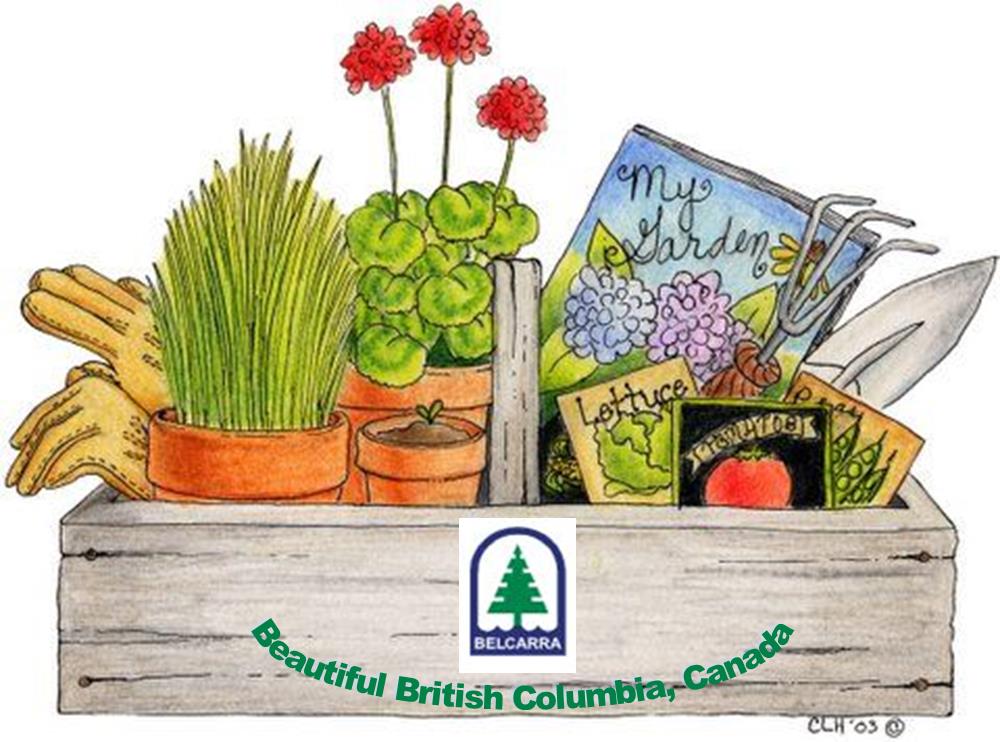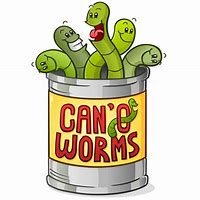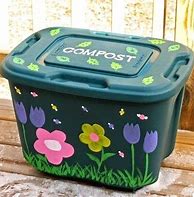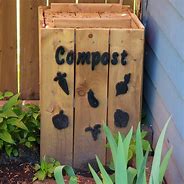Belcarra Garden Club
BC, Canada

May 2022
A Worm Can Compost… Can you?
By Nora Boekhout and Les Bramley

The May meeting was definitely a “can of worms” in a manner of speaking!
Les gave the group a great introduction to Earthworms and composting. (Spoiler alert: composting is a not only a great way to dispose of your kitchen scraps but it’s also beneficial for Mother Nature!)
Earthworms, to distinguish them from other types of worms such as tapeworms, are segmented worms called annelids. Did you know that Earthworms have 90 to 150 segments, with five hearts, a circulating system, a mucus system, a brain, a reproductive system, and a nervous system too! Who would have guessed that those little guys were so complex! They are an invertebrate, which means that they have no external or internal skeleton. All the major organs are located in the front quarter of the body; the back three-quarters is intestinal tract. They do have a mouth but no teeth. Ever wonder which end is the front? Look for a smooth ring, called the clitellum, at the one-quarter mark. You may also notice that he body segments get progressively smaller towards the head. Contrary to some beliefs, a worm cut in half will not result in two worms although the front end may survive. Worms have a unique squeeze-extend muscle system for movement, very different from snakes. Worms breathe through their skin, which is why they need moist conditions. They have a gizzard which grinds food and organs which release nutrients from organic matter. The resulting castings make for wonderful rich compost containing Nitrogen, Phosphorus, Magnesium, and Potassium. In addition to that, earthworms aerate the soil by digging tunnels. This helps oxygen and water pass through easily, and mixes the soil from lower and upper layers This is very good news for plant roots! Earthworms are the prey of many animals including birds, snakes, and amphibians.
Worms can breed from 90 days old and can live 10 to 15 years. They are Hermaphrodites, which means that every worm has both male and female organs. They can mate every 7 to 10 days, but the mating process takes about 24 hours! If you have ever noticed a whitish ring around an earthworm? It is a gelatinous ring formed at the clitellum, called a “capsule”, and it will slip off into the soil to become an oval cocoon. After two to three weeks, 2 to 20 baby worms emerge. Up to 50 capsules may be laid per year.
 |
 |
Outdoor composting is a fantastic way to save on the use of fertilizers and chemicals! You already are putting your kitchen scraps into the Belcarra Recycling compost bin, aren’t you? Why not save some to create compost for your own garden? By the way, do you know why it’s so important that your kitchen scraps don’t go into the regular landfills? Organic matter that gets mixed in with “garbage” usually ends up underneath other waste. Anaerobic (no oxygen) bacteria break down this organic waste, and produces toxic leachate and poisonous greenhouse gases such as methane and carbon dioxide! Landfills rank third in the production of human-caused methane. That’s why it is so important to separate your organic scraps from household garbage.
There are many commercial composters available, or if you are handy, there are also many DIY (Do It Yourself) directions online. If you’ve never tried it, consider your outdoor plant scraps and lawn clippings into your first compost mix. Of course, be sure not to add any meat scraps or you will be attracting our neighbourhood bears or those annoying rodents! Indoor composting is another alternative. It doesn’t even smell! Again, there are small to large commercial containers to suit your indoor space. (Nora used to have one right in her classroom!) There are also simple DIY bucket systems to consider as well.
Earthworms are well suited for outdoor composting, as they prefer a cool environment, of about 10-15degrees C. Red Wriggler worms are more commonly used for indoor composting as they tolerate wider temperature ranges, breed quickly, and process more organic material. A pound of these worms can consume up to a ½ pound of food scraps per day! Red wrigglers (Eisenia fetida) are epigeic, which means they feed on the surface unlike earthworms that burrow in the ground.
|
 Red Wriggler Worms |
Now for the “downside” information, and doesn’t there always seem to be one of those! Were you aware that our wonderful worms are not only our garden buddies, but are technically an “invasive species” here? Scientists believe that the ice age 10,000 years ago killed off the worms in North American. European settlers reintroduced worms. There are about 6,000 species of worms and approximately 120 species are widely distributed around the world. They are prolific and Charles Darwin estimated that there may be 50,000 in an acre! The four most common are the Red Worm, Tiger Worm, Field Worm, Night Crawler. Some species are only 3 or 4 cm long, but there is an Australian worm that measures 3 meters!
Here’s the bad news. Scientists say our forests are being changed forever by various worms eating increasing amounts of the decaying matter (the leaf litter layer) on the forest floor. The competition for food is killing other insects, and causing a 50% decrease in native invertebrates. Salamanders eat worms but the baby salamanders can choke on the larger worm species and die. The worst news is that worms are reducing the Boreal forests capacity to store carbon, and this is currently estimated to be a 10% reduction. Because a large portion of the world’s boreal zone lies in Canada (28% or 552 million hectares), this country’s boreal forest affects the health of the environment worldwide. Boreal forests are high-latitude forests, able to withstand 6-8 months of freezing temperatures. The forests with mostly conifers, as opposed to broadleaf deciduous trees, are less highly effected, as earthworms do not prefer that kind of soil or leaf litter.
Some type of worms, like the Jumping Worms from Korea and Japan, are ravaging the soil throughout the USA and have crossed the border into Canada. Jumping worms are larger and recycle nutrients even faster than our typical earthworms. They quickly churn the top layer of soil and leave it looking something like coffee grounds.
A worm can only travel 30ft per year but we carry them about unknowingly. Worm capsules are easily transported by tire treads, boats, gardeners, and soils. Fishermen often dump out their worms at the end of a fishing trip,
So, as with everything else it seems, our world is changing. While earthworms may be our “backyard buddies” here, it is important to think about protecting our forested areas. Just as we are working on reducing invasive plants such as Lamium, English Ivy, and knotweed, we also need to be careful not to introduce potential threats into our forests. Stopping transport of worms is an important preventative measure. Hikers need to clean their boots before heading out into forested areas. Give your car tires, boat, or trailer a rinse before heading into back areas. Don’t dump your fishing worms thinking that they are just food for wildlife.
If you’d like to know more about earthworms, composting, or the changes in our boreal forests, explore the links below. You can check out our newly created “Belcarra Garden Club” webpage for even more references and information. Earthworms are a fascinating learning project for children too, so check out some ideas and links on (Nora’s) Nature’s Classroom: Earthworms webpage.
Belcarra Garden Webpage Extra links:
Vermiculture: Worm Composting: for Children
http://www.teacherwebshelf.com/naturesclassroom/nctitlepage.htm
Earthworms:
https://www.ranker.com/list/earthworm-facts/eric-vega
https://wormfarmguru.com/amazing-worm-facts/
https://byjus.com/biology/earthworm-morphology-anatomy/
https://www.thecanadianencyclopedia.ca/en/article/earthworm
Red Wriggler worms:
https://www.wormwoman.com/choosing-the-right-worm-for-your-bin/
https://urbanwormcompany.com/guide-to-red-wigglers-eisenia-fetida-composting-worm/
https://redwigglersupply.ca/worm-facts/
Composting:
https://www.wormcomposting.ca/
https://www.thespruce.com/search?q=compost+bins
https://homesteading.com/your-ultimate-guide-to-diy-compost-bins-for-homesteading/
http://www.metrovancouver.org/services/solid-waste/SolidWastePublications/HeresTheDirt.pdf#search=%22Composting%22
Invasive worms
https://www.cbc.ca/news/science/invasive-earthworms-threat-forests-climate-change-1.6154164
https://dnr.wisconsin.gov/topic/Invasives/fact/jumpingWorm.html
http://www.invadingspecies.com/invaders/forest/invasive-earthworms/
https://www.nationalgeographic.com/animals/article/earthworms-invasive-north-america-hurt-insects
https://ofnc.ca/programs/macoun-field-club/study-area/invasive-earthworms
Ways to help stop the spread of invasive species:
https://www.ontario.ca/page/invasive-species-ontario
http://www.actongardenclub.org/invasive-jumping-worms-information-best-practices-to-stop-the-spread/
![]() Back to Belcarra Garden Club
Back to Belcarra Garden Club
![]() Back to Nature's Classroom
Back to Nature's Classroom
This page created May 2002.
 Earthworms
Earthworms